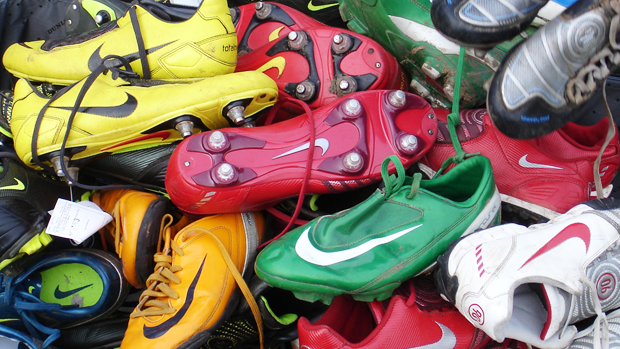
Next to Energy, Transport, and Agriculture, Fashion is the world’s most polluting industry- and football is not an innocent bystander.
It’s estimated that football apparel alone is responsible for .4% of total global carbon emissions. The fashion industry itself is responsible for 8-10% of global emissions. If nothing changes, an increase of 50% of global carbon emissions is expected within a decade – just from fashion.
This is a pressing matter as football already has a large impact on global carbon emissions. But, also because the latest IPCC report explains that all the tools necessary to avoid global warming from exceeding 1.5C already. We just have to act now.
The environmental burden of the global fashion industry can be cut down significantly by adopting a circular economy and that can be reached by reducing, reusing, and recycling our clothing garments.
Through football, we can begin to adopt these sustainable attitudes and actions regarding our apparel and shoes. By doing so, we can start the chain reaction necessary to lessen the overall burden of the global fashion industry for good.
But first, it’s important to get a better idea of what’s going on with the football garment industry, and how we can change it for the better.
The quick explanation as to why football apparel is such a burden to the environment is due to the pollutive materials used to make garments and shoes, and its exorbitant over-production.

Football kits are primarily comprised of synthetic fabrics such as polyester, spandex, nylon, plus a very water-consuming and deforestation-inducing cotton.
The synthetic fabrics used are mostly derived from petroleum, and therefore emit major amounts of carbon emissions throughout the entire process of material harvest, creation, and disposal. Not to mention, the synthetic dyes used to color these materials, and the microplastics that come off of these garments in the washing machine cause much harm to our biodiversity, especially within our oceans and rivers.
If the method of harvest and production wasn’t polluting enough, the sheer amount of apparel and shoes produced and thrown away each year is devastating our environment.

Image source: CALPRIG
According to the World Resources Institute, the average consumer is purchasing 60% more clothing garments compared to 2000, but each garment is kept half as long. Accumulation of unwanted or unused apparel in landfills is typically burned. The burning of these petroleum-derived materials produces a high amount of carbon dioxide, thus demonstrating why fashion is one of the world’s most polluting industries.

Picture Source: Soccer Bible
In the professional football world, it is common to find clubs that provide new kits for each player for every game. However, it is no secret that club and team sponsorships produce a large number of football garments that are used and then replaced at least once a season, regardless of the garment’s continuing utility.
These kits are then sold to the public, often in high quantities due to high demand. Just last year (2021), Bayern Munich sold the most football kits in the world, racking up a value of 3.25 million units sold.
Similarly, Serie A’s Napoli has released 10 club shirts for their entire 21/22 season. Several of the 10 shirts were launched in relation to unique events, such as the death of Diego Maradonna and Halloween. However, all thematic shirt replicas produced by Napoli’s sponsor, Giorgio Armani, had sold out on Napoli’s official store thus showing that on top of club demand, consumer demand is still present.
On top of the environmental burden consumerism presents, it’s important to mention that it also threatens human rights. Many large retailers outsource garment production to global south countries with lax labor, safety, and environmental regulations, and therefore exploit the land and individuals to maximize profit. Also, the higher the demand for trends, the harder these individuals have to work.
Thus, it is clear that there is much work to be done on behalf of individual consumptive behavior, and the global fashion business model. However, If things do not change now, keeping global warming to under 1.5 °C, will be almost impossible. Most importantly, we still have some time, and actions available to avoid the worst from happening- and these efforts can start with football.
There are many tools and strategies available for individuals, corporations, and governments to act on to lessen the environmental burden global fashion industry. The most effective thing to do now as individuals is to reduce, reuse and recycle by wearing our things longer, buying items made with sustainable materials, and stopping the demand for over-production by not giving in to trends as often.
Despite the many emerging sustainability initiatives coming from corporations, one must still be wary of greenwashing. The IPCC made it clear that current business models and practices must change, but if they are not changed now, it may be too late. Therefore, it is up to the collective actions of individuals to set in motion the green chain reaction of sustainable attitudes and actions that are necessary to save the planet.
Through football, we can mobilize 3.5 billion people to lessen their individual carbon and environmental fashion footprint, as well as send a message businesses and governments cannot ignore. Lessening the environmental burden of the global football apparel industry is just the beginning. Through football, we can save the planet.
Reduce:
Reuse:
Recycle:

We Play Green has an action project ready to launch called the “Green Bag”. This bag’s purpose is to stop the cycle of needless fashion consumption and disposal within all levels of the football world. This bag will act as a collection point to re-use, re-make, and properly dispose of viable textiles, clothing items, and shoes beginning with recreational and professional clubs in Norway.